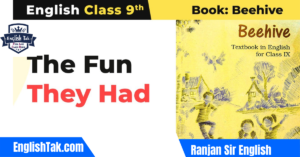![]()
Lost Spring Long Question Answer
Table of Contents
Lost Spring Long Question Answer – Welcome to the analysis of “Lost Spring Class 12” question answers in English. This guide provides clear explanations of Anees Jung’s touching story. It explores the lives of street children and bangle makers in Firozabad, uncovering the societal issues they face. Explore the structures and difficulties that influence their lives in this narrative.
Join Our Telegram Group for Pdf
Lost Spring Long Question Answer
Answer the following questions in 120-150 words:
1. Certain traditions and lineage, condemn thousands of children to a life of abject poverty and choke their aspirations. Do you agree? Explain.
How can we change this? Suggest some ways to tackle this issue.
[CBSE Question Bank 2021]
Ans. India has some great traditions like respecting elders, looking after one’s parents and living in a close-knit family. However, some traditions need to change because they treat people badly. One of them is the idea of following a family business irrespective of whether the child likes it or not. Not all children are alike. A trader’s child need not be a trader against his/her will. A bangle seller’s child need not become a bangle seller. We have to change this endless cycle of forced slavery. There are two major weapons which will help. One is education. Children should be educated in order to break the cycle. The second is health. Children have to be given access to good food, regular exercise and health checkups. This help will have to come from either the government or altruistic individuals. Only then can this issue be tackled.
2. ‘Food is more important for survival than an identity.’ Examine ‘Lost Spring’ by Anees Jung in light of this statement.
Ans. The ragpickers of Seebmapuri came from Dhaka in Bangladesh. They travelled a long distance to get to the outskirts of Delhi. This migration was not voluntary. Their homes and fields were washed away by harsh storms. So, they had to move to a place where they could at least be able to eat. When the moved from their country, they lost a part of their identity. When they arrived here, they had to live near garbage dumps in Seemapuri in temporary shelters made of tin and tarpaulin, without proper running water, sewage or drainage facilities. For thirty years, they stayed here without proper identity. Because of their Indian ration card, they could get some provisions. Even these appalling conditions were preferable to starvation. This is why one of the women from Seemapuri said that food was more important than an identity.
3. Is the title of the story ‘Lost Spring’ apt? Justify or suggest an alternate title and explain why it is better. [CBSE 2010]
Ans. Yes, the title of the story ‘Lost Spring’ is apt. The story revolves around the lives of the children of Sahibganj, who are deprived of basic necessities and forced to work in hazardous conditions. They are unable to enjoy their childhood, which is often seen as the ‘spring’ of life. The title is also symbolic, as spring is a time of new beginnings and growth. However, for the children in the story, spring has been lost.
An alternate title for the story could be ‘The Stolen Childhoods’. This title would be more direct and would highlight the fact that the children in the story are being robbed of their childhood. However, I believe that ‘Lost Spring’ is a more effective title, as it is more poetic and evocative. It also captures the theme of the story more effectively.
4. What possible health hazards affect rag pickers like Saheb?
Ans. Ragpickers face many health risks because of their work conditions. The places they work in are not safe, and there are chances of getting sick. When food waste mixes with other wastes, there’s a risk of infection from spoiled food. Ragpickers also don’t have clean water for washing or drinking, so they can easily get sick with dysentery and diarrhea from eating food found in the garbage. Electronic waste, including devices with batteries, like car and phone batteries, is not separated. This means harmful metals like lithium from batteries can mix with the garbage and soil, posing a danger to ragpickers who handle battery waste. Additionally, inhaling the smoke from burning garbage puts them at risk of respiratory diseases.
5. What health hazards affect the bangle sellers of Firozabad? [CBSE 2015]
Ans. Bangle making is one of the most hazardous industries to work in. There are quite a few health hazards associated with it. First of all, workers work in badly lit conditions under the light from oil lamps. They spend long hours working in near darkness, thereby losing their eyesight as the years go by. Second, the processes of the industry such as glass blowing and welding involve being exposed to high temperatures. This leads to heat stress, where the body is under stress from heat. Third, since bangle making does not bring enough money, nutrition is a problem as well. People who work in the bangle industry do not have access to proper food. Finally, children are employed in this industry, which means all the problems they face have an impact on the next generation.
Don’t Miss these Posts
Lost Spring Long Question Answer For 2023-24 Exams
6. Describe the life of women in the bangle making industry.
Ans. As seen in the case of Savita, girl children in the bangle industry are inducted quite early. They become experts in bangle making, mechanically working like a machine. They might not even know the significance of the bangles they make. The conditions of work are horrifying as workers sit in gloomy and drab cells facing high temperatures from the furnaces. They shape molten, coloured glass into brittle, coloured glass bangles. Both men and women face the same torrid work conditions. Over time, they lose their eyesight as seen in the case of the old woman who sits next to Savita. One added disadvantage for women is that they have the added responsibility of taking care of the house and hearth.
7. Imagine you are Tishani Doshi, the author of ‘Journey to the end of the Earth’. You come across Anees Jung’s account of rag-pickers in Seemapuri who were forced to leave their native lend due to climate changes. Write an account describing them as ‘climate refugees’.
Ans. Climate refugees are people who are forced to flee from their country/city because of drastic changes in the weather or natural environment which affects their livelihood. This could be flooding, drought, desertification, rise in sea levels or unseasonal weather patterns. poldo Another term for them is ‘environmental migrants’. ‘Refugee’ carries the sense of being persecuted. But climate refugees are not fleeing because they are being persecuted in a legal sense. They move from one place to another to survive. Climate refugees can migrate within the same country or to another country. Saheb and his family left Dhaka, Bangladesh because their fields and homes were washed away by many storms and edor migrated to Seemapuri, India. Hence, they can be considered climate refugees.
8. What would it take for Mukesh to achieve his dream?
Ans. Mukesh has to hold on tight to his dream as he grows up, even when things get tough. Life might not be easy for him, so he has to be persistent and overcome the challenges to chase his dream. He might have to work as a bangle maker for a while just to pay for his Automobile Mechanical Training. Another option is to learn on the job by apprenticing himself to a mechanic. Convincing his parents and grandparents to support him will be the hardest part. It might take many years, but if he stays determined, he can make his dream come true.
9. Mukesh finds himself caught between two distinct worlds. How do they affect his life and that of the other bangle makers?
[Delhi Gov. QB 2022]
Ans. Mukesh is caught between two distinct worlds. One is the crippling society of Firozabad where bangle makers live a life less than human, oppressed by both traders and government authorities. On the other hand, he is also part of the larger world which has moved on and developed. He wants to become a motor- mechanic when he grows up so that he does not have to continue with the drudgery of the bangle making business. But it seems like a distant dream because the social evils present in the bangle making industry will not let him escape easily. The same dilemma is present in the other bangle makers as well because they are trapped in a vicious cycle that will not let them escape their ‘god-given lineage’. It kills their dreams and spirit, breaking them until they have no resolve left to fight their so-called destiny.
10. How does the story, ‘Lost Spring’ highlight the apathy of society and those in power to end the vicious cycle of poverty? Support your answer with textual evidence.
[CBSE Question Bank 2022]
Ans. ‘Lost Spring’ refers to the loss of childhood and innocence of children who are from families below the poverty line. We come across various examples of apathy by people in mainstream society and those in power towards such children. For example, children like Saheb are eager to go to school, but it seems like a far dream in reality. They are excluded from society and rendered invisible in the eyes of people who have the resources and power to provide them with a better life. On the other hand, Mukesh and his family live under the constant oppression of middlemen, politicians, the police and moneylenders who are only bent on exploiting them to the fullest. These show a classic case of the people in power preying on those who are weak and at their mercy.
Lost Spring Long Question Answer Download Pdf
English For Class 12th Board Exams
The Interview Summary Class 12 English
Aunt Jennifer’s Tigers Summary





